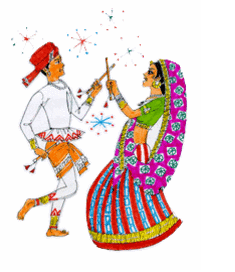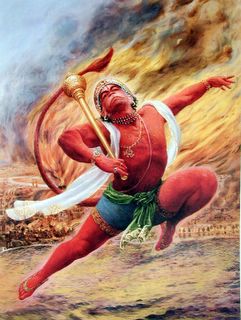Did you know that there were other forms of Gujarati dance apart from the Raas and Garbo? The article below gives a brief description of each.
 Gujarat, during the 9th century, was divided into four regions: Saurashtra, Kachchh, Aanara and Laat (south Gujarat). Raas, Garba, Hudo, Tippani are the dance forms of Saurashtra, while Dangi of Dharampur and Holi Nritya from Kawant are attributed to Laat. Garba, Garbi and Bhavai are the dances from Aanarta (north Gujarat), while Siddi Dhamal, Matukadi, Ged-do are original dances of Kachchh. Ideally, two circles formed by men and women move in clockwise and anti-clockwise directions with two sticks called dandiyas held in their hands. The song sung on the occasion is essentially an amorous one. Raas is a very energetic, colourful and playful dance providing opportunity for acting and exchanging messages through eye contact. It is no wonder that many romances bloom during Navaratri and hence the popularity of the dance among the younger generation.
Gujarat, during the 9th century, was divided into four regions: Saurashtra, Kachchh, Aanara and Laat (south Gujarat). Raas, Garba, Hudo, Tippani are the dance forms of Saurashtra, while Dangi of Dharampur and Holi Nritya from Kawant are attributed to Laat. Garba, Garbi and Bhavai are the dances from Aanarta (north Gujarat), while Siddi Dhamal, Matukadi, Ged-do are original dances of Kachchh. Ideally, two circles formed by men and women move in clockwise and anti-clockwise directions with two sticks called dandiyas held in their hands. The song sung on the occasion is essentially an amorous one. Raas is a very energetic, colourful and playful dance providing opportunity for acting and exchanging messages through eye contact. It is no wonder that many romances bloom during Navaratri and hence the popularity of the dance among the younger generation. Garba - Mainly performed by females in a circular formation, it is in reverences of goddess Ambaji. The basics of the dance are singing and clapping rhythmically while going round the goddess. Today, many modifications are prevalent to the basic pattern and even men are free to join in.
Garbi - Originally men use to perform this dance. It was on the way back from a battle that the victorious army would start dancing to couplets and amorous songs sung by the Charanswar, or the narrators who used to go to the front to raise the spirit during the battle by singing songs of valour. The dance was characteristic for its forceful movements which would fascinate viewers. Today, however, even females participate in the dance.
Hudo - It is the dance of the Bharwads, the shepherd community. The idea of the dance originated from sheep fights. The movements of two sheep ramming their heads is duplicated in the dance in which the dancers clap hands in a forceful and rhythmic manner.
Tippani - Many dance forms evolved from daily routine, and Tippani is one of them. It is the dance form of the labourers who are breaking stones or levelling the ground to break the monotony of the work. Females perform this dance with sticks in their hands which they strike on the ground to the beats of the drum.
Dangi - A dance form of the tribals from Dang, it is performed by both men and women. Dhol and pawri are the accompanying instruments of the dance which is highlighted by gymnastic skills. The strength and power of the dancers is depicted by the movement and the formation of pyramid spirals.
Dharampur - A dance which derives its name from the area. A tribal dance in which men paint their bodies and dance with weapons. Women join in dressed in colourful outfit.
Holi Nritya - A dance performed during Holi by the tribals of the eastern ghats of Gujarat. The dancers are dressed in peacock feathers on their head and waist and dance through the streets.
Siddi Dhamal - A unique dance style of Kachchh. The dancers dance with two thin sticks exhibiting their art and skill while dancing.
Ged-Do - Dance forms in this style of dance from Kachchh exhibit a complicated footwork by moving in a peculiar style akin to the movement of a horse in the game of chess. The dance also has a peculiar drum beat.
Matukadi - A female dance form from Gujarat, it is a very graceful one in which the dancers dance in a circular form in pairs.
Bhawai - This folk form enjoys the reputation of being the most entertaining style of dance from north Gujarat. It was on the verge of extinction after independence.
This post is especially for the Gujaratis out there!

2 comments:
HARIBOL,VERY NICE..GOD BLESS..KEEP UP THE GOOD WORK..GOD'S WORK..HARIBOL
Before, I always lived in anticipation . . . that it was all a preparation for something else, something "greater," more "genuine." But that feeling has dropped away from me completely. I live here and now, this minute, this day, to the full, and the life is worth living. -- Etty Hillesum
Post a Comment